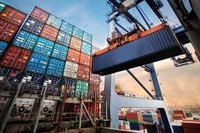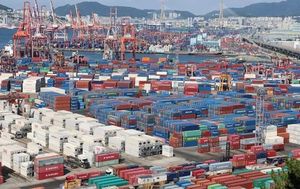In a move that’s sent shockwaves through global agriculture, China has dramatically shifted its soybean purchases away from the United States, favoring Argentina after Buenos Aires temporarily suspended its grain export tax. The result? At least 20 shiploads—some estimates say 10 to 15 Panamax cargoes for November arrival alone—of Argentine soybeans have been snapped up by Chinese buyers in a matter of hours, according to Reuters. This sudden pivot, coming during America’s prime export window, has left U.S. farmers reeling and market analysts scrambling to assess the long-term consequences.
The catalyst for this upheaval was Argentina’s decision to temporarily waive its 26 percent export tax on soybeans, a policy shift announced for October or until declared exports reach $7 billion. The move instantly made Argentine soybeans cheaper and more competitive on the world market, undercutting U.S. offers from the Gulf and Pacific Northwest. Within hours, Chinese importers locked in the cargoes at a cost-and-freight premium of $2.15 to $2.30 per bushel over the CBOT November soybean contract, as reported by Reuters.
The ramifications were immediate. Chicago soybean futures dropped to a six-week low, and U.S. soybean sales to China for the new crop marketing year fell to zero—a stark reversal for what has historically been America’s largest export market. As China’s Dalian soymeal and soyoil futures tumbled about 3.5 percent on expectations of cheaper Argentine supplies and improved crush margins, American farmers faced mounting pressure from falling prices and evaporating demand.
For U.S. producers, the timing couldn’t have been worse. “Every time China turns to South America instead of the U.S., soybean farmers and our farm families here at home lose out,” said Caleb Ragland, a Kentucky grower and president of the American Soybean Association (ASA), in an interview with Reuters. His frustration echoes across the Corn Belt, where the sense of being left behind is growing with each missed shipment.
At the root of the crisis are the ongoing trade tensions between the U.S. and China. In response to American tariffs on Chinese goods, Beijing imposed a 20 percent tariff on U.S. soybeans—a move that has driven Chinese buyers to look elsewhere. “The farm economy is suffering while our competitors supplant the United States in the biggest soybean import market in the world,” Ragland told Reuters, urging the White House to prioritize securing an immediate deal on soybeans with China. “U.S. farmers cannot wait and hope any longer.”
Brazil, already China’s top soybean supplier, has now been joined by Argentina as a major beneficiary of the shifting trade winds. While Brazil’s dominance remains unchallenged, Argentina’s sudden export tax waiver has tilted the playing field further away from the United States. According to Gustavo Idígoras, head of Argentina’s soybean crushing chamber, “The temporary tax cut encourages China to take Argentina’s soy.” But there’s a catch: Argentine crushers warn that the surge in whole-bean exports could tighten domestic supply, potentially impacting the country’s own processing industry.
Market analysts see China’s move as a calculated effort to avoid U.S. soybeans during America’s peak export season. “China is trying to avoid the U.S. during our export window,” said Ted Seifried of Zaner Ag Hedge, highlighting the strategic nature of Beijing’s purchases. Earlier in the year, China had engaged in heavy buying of U.S. soybeans—lifting imports to record monthly highs and boosting inventories as a hedge against possible fourth-quarter disruptions. But with November cargoes now lining up from South America, the U.S. finds itself shut out, at least for the time being.
The broader impact of this trade drama extends far beyond the Midwest. Global businesses, from Indian exporters to multinational food companies, are being forced to rethink their strategies in the face of unpredictable tariffs and shifting alliances. As KPMG analysts point out, companies are diversifying export destinations, renegotiating contracts, and investing in more resilient supply chains to weather the volatility. The goal is clear: minimize risk and maintain stability in a world where trade relationships can change overnight.
Back in Argentina, the government’s policy is not without its own risks. The tax suspension is set to last only until exports hit the $7 billion mark or the end of October, whichever comes first. Once that cap is reached, the export tax could snap back into place, potentially altering the competitive landscape yet again. For now, though, the window of opportunity has allowed Argentina to seize a massive share of the Chinese market—at least temporarily.
Meanwhile, American farmers are left grappling with uncertainty. The rapid shift in Chinese purchasing patterns is already reshaping planting decisions, supply chain contracts, and even the long-term viability of family farms across the United States. According to Reuters, the sense of desperation is palpable as the ASA’s urgent calls for action go unanswered and the harvest season gets underway with little hope of a turnaround.
Looking ahead, all eyes are on two key factors: whether Argentina’s $7 billion export cap will be reached before the end of October, and whether any progress in U.S.-China trade talks can revive American soybean sales later in the year. For now, the message from the market is clear—tariff wars and diplomatic standoffs have real, lasting consequences for the people who feed the world.
As the U.S. government continues to negotiate a $200 billion swap line to support Argentina’s economy, the irony isn’t lost on American farmers who feel abandoned by their own policymakers. While Washington focuses on macroeconomic support for foreign governments, the livelihoods of domestic agricultural producers hang in the balance. The stakes could hardly be higher: every policy decision, from a tariff hike to a swap line negotiation, sends ripples through global farms, ports, and dinner tables.
Ultimately, the story of soybeans in 2025 is about more than just crops and contracts. It’s a vivid reminder of how interconnected—and fragile—the global food supply has become. Unless the U.S. can find a way to rebuild trust and reopen its markets, its farmers may find themselves permanently sidelined in one of the world’s most vital export arenas.
This season’s soybean saga stands as a warning: in the high-stakes world of international trade, fortunes can shift in a heartbeat—and those who feed the world can just as quickly find themselves left out in the cold.




